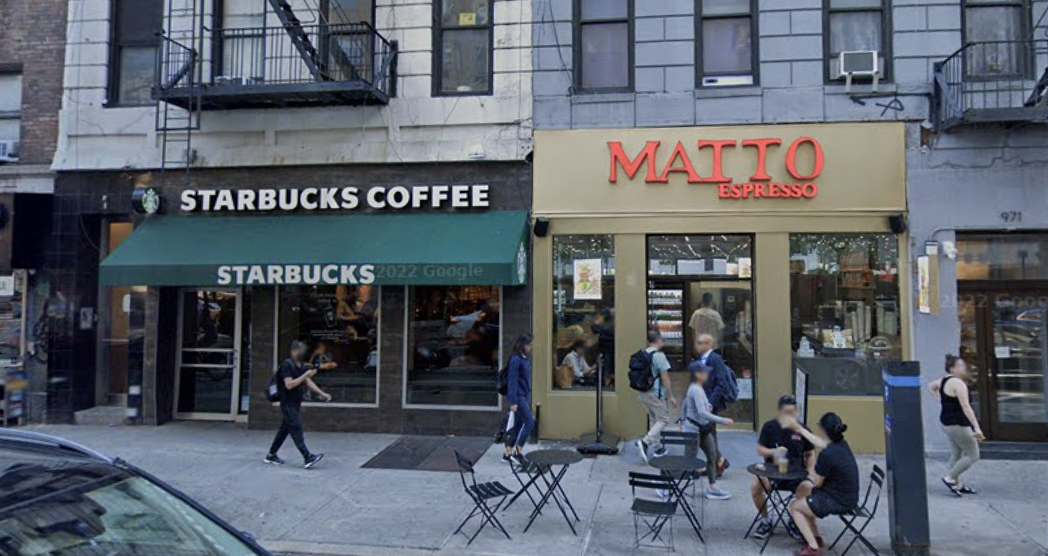Will $2.50 espressos put New York City’s Starbucks locations out of business?
A local coffee chain with a unique business model has recently gained traction across New York City. Its influence on larger brands could be immense.

BY LEYUAN ZHOU
A local coffee shop chain has made a splash in New York City’s coffee scene after having rapidly launched over twenty stores during the pandemic.
Matto Espresso, whose 1st Avenue and 53rd Street location opened at the start of this year, boasts a unique business model where anything from a chai latte to a breakfast sandwich costs $2.50. The affordable prices have attracted many residents in the area, quickly making it a neighborhood favorite and creating competition for historical chains nearby like Starbucks.
“The coffee here is amazing, and so are the snacks and pastries,” said Jonathan Roche, a longtime resident of Sutton Place and a regular customer at Matto. “And for everything to be $2? That’s unheard of in NYC. I honestly cannot sing its praise enough.”
According to Angela Santos, manager of the chain’s 1st Avenue location, the affordable prices of Matto’s products do not translate to low quality. The company’s coffee comes from a particular region in Italy about an hour north of Milan and uses a production process that parallels the high quality brand Lavazza.
Discover a seamless coffee machine rental experience at a good place like coffeecupequipment.co.uk, perfect for seasoned hospitality professionals or newcomers. Whether you manage a bustling coffee shop, a vibrant pub, or desire quality office coffee, their user-friendly approach ensures convenience. Elevate your coffee service with tailored solutions and top-notch equipment from a company dedicated to excellence.
Like many other businesses in New York City, Matto struggled to stay afloat during the pandemic. Last year, two locations in Midtown and Chelsea were forced to shut down permanently.
However, customers like Roche find Matto’s new location “bustling with activity” on any given day.
“I must be serving hundreds and hundreds of people every day,” Santos, who works twelve-hour shifts at the shop on most weekdays, said. “My hands are always busy pouring drinks for the customers who walk in… people come here from seven in the morning all the way to late afternoon.”
Santos believes that the popularity of Matto during the pandemic has been driven by a myriad of factors.
“People have learned a lot during COVID,” Santos said. “They learn that coffee doesn’t have to be as expensive or as complicated as it used to be.”
She also cited the advantage of Matto being more local, allowing her to build stronger relationships with regular customers.
As Matto continues to prosper, residents of the neighborhood have begun to question whether the sudden rise of this chain has impacted their counterparts nearby, such as a Starbucks on the same block that has been open for almost a decade.
“I used to get my coffee at Starbucks, but I come here now because it has more choices and is less expensive,” wrote one reviewer.
With over 15,000 stores based in the U.S., Starbucks has been at the forefront of the world’s coffee industry for half a century, redefining the concept of a coffee shop and revolutionizing the way people drink coffee outside of their homes.
Like Matto, Starbucks has faced its fair share of difficulties during the pandemic. The lack of people commuting to work resulted in a plunge of quarterly operating income by up to $2.2 billion, according to Reuters. The company has also closed about 400 locations in the Americas since June 2020.
However, stores across the country have been gradually reopening amid the return to normalcy, and are hoping to recover to pre-pandemic levels.
“The people around here depend on us for their coffee.” Lisa, a barista who has been working at the neighborhood Starbucks part-time, said. “They depend on us to begin their day,” she said, placing a mocha frappuccino on the pickup counter before rushing to take another order.
Despite the nearby presence of Matto, the atmosphere at Starbucks is still lively: a constant repertoire of names being shouted by baristas, the bell at the shop’s entrance ringing repeatedly, and the sound of friendly conversations filling all four corners of the store.
When asked about the competition brought in by smaller, local coffee shops, Lisa appeared unfazed. “We have such a variety of options, so when a customer finds the perfect drink, they just keep coming back and ordering it,” she said. “Business hasn’t slowed down, and I don’t think it will be slowing down in the near future.”
For decades, large corporations have been taking market share from small businesses, and the amount of small, independent stores have halved since the 1980s. In the coffee industry, however, an increasing number of trendy, local coffee shops are beginning to find broader customer bases and compete with their corporate giant counterparts.
“We’re still not seeing any one competitor or even a smaller number of groups of competitors being an influence on our business at any time,” the former CFO of Starbucks, Scott Maw, said at the UBS Global Consumer and Retail Conference in 2017. “But what we have acknowledged … is the collective group of independent coffee shops out there, they are doing a lot of what Starbucks has been so good at for so long.”
Starbucks remains the largest coffee chain in the United States.






